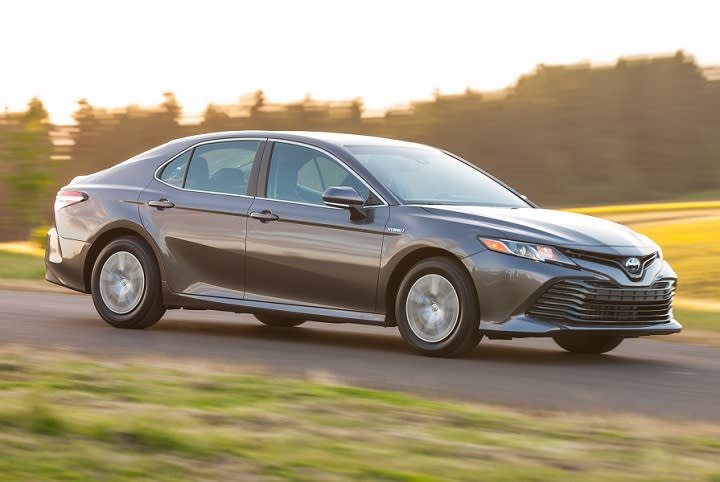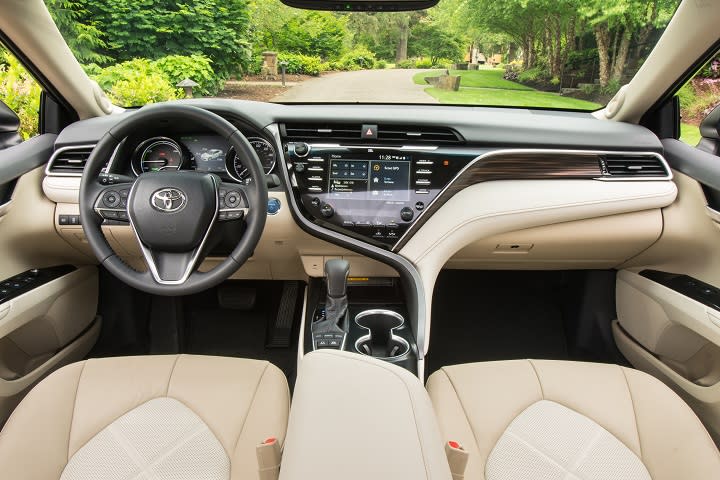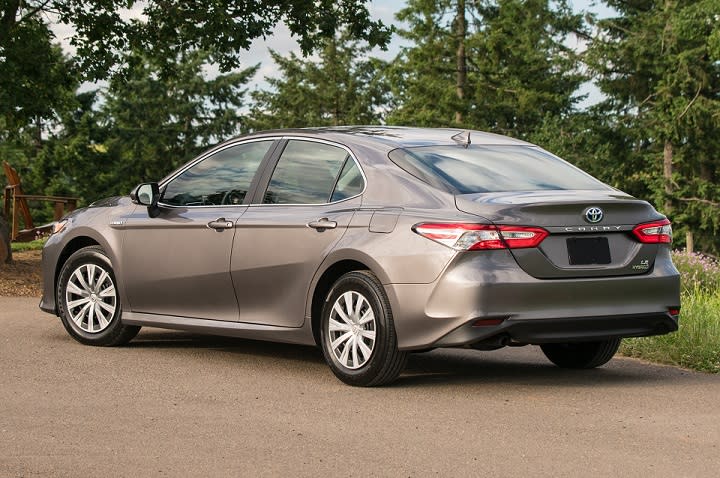Test Drive: 2018 Toyota Camry
Introduction
Toyota redesigns the popular Camry for 2018, aiming to give the car more style and improved driving dynamics while expanding availability of safety technology and introducing next-generation infotainment systems.
Built on Toyota’s new global vehicle architecture, the 2018 Camry is a bit smaller inside than it used to be, and it sits lower to the ground. The result is a car that is more fun to drive and wrapped in sleeker sheet metal.

Three powertrains are available on the new Camry. The L, LE, SE, XLE, and XSE are equipped with a new 4-cylinder engine and 8-speed automatic transmission. An upgraded V-6 engine is optional in the XLE and XSE. A more powerful and efficient gas-electric hybrid is offered in LE, SE, and XLE trim.
I headed to Portland, Oregon to sample from the buffet that is the 2018 Toyota Camry, and came away undeniably impressed.
Styling and Design
Designers created two distinct looks for the new Camry.
The SE and XSE have a racy appearance, complete with what Toyota says is “catamaran-inspired” front styling. Oversized fake front air intakes lead the way, a body kit dresses up the rocker panels, and a rear diffuser panel is bracketed by up to four exhaust outlets when the maximum number required is two.
These versions look just a tad bit silly, advertising far more performance than they actually supply. Choose the XSE and you can get a custom black painted roof, along with red leather seats that are just a hue or two too bright.
My preference is the more conservative styling of the L, LE, and especially the XLE. Though the lower grille is somewhat overdone, the rest of the Camry XLE looks exactly right, from its tautly tapered headlights and lace-spoke 18-in. wheels to its Lexus-like rear end. Notably, aside from discreet badges, the efficient Camry Hybrid variants looks exactly like their 4-cylinder and V-6 counterparts.
Features and Controls
Inside, the 2018 Camry receives a dramatically styled dashboard that emphasizes Toyota’s newfound focus on the driver. The usefulness of the controls is uncompromised by this approach, and Toyota supplies a positively enormous center console between the front seats.
Still, this car feels smaller, a sensation backed up by shrinking interior measurements when stacked up against the 2017 model. Comfort levels are excellent up front, unless you want seat ventilation, which is unavailable at any price. All versions except for the base Camry L are equipped with front-seat height adjustment, a good thing given that seating hip points are lower than before.

Rear-seat occupants might not be quite as satisfied. The seat cushion is lower, making it harder to enter and exit the car. Legroom also feels a little tighter. And unless you get the mid-level version of the Entune infotainment system, which is bundled with a dual-zone automatic climate control system, you won’t get rear air conditioning vents. There are no USB ports in the back seat, either.
As is expected, feature count rises as a buyer climbs the trim level ladder. Highlights include various sizes of aluminum wheels, power sunroof or a panoramic glass sunroof, leather seats, keyless entry with push-button starting, premium sound system, and a number of safety and infotainment upgrades.
Safety and Technology
The outgoing 2017 Camry is a safe car, but to unlock access to many of its driver-assistance and collision-avoidance systems, you need to pay extra for a higher trim level.
In 2018, this changes to a large degree. The new car, which employs a stiffer underlying vehicle architecture, is equipped with Toyota Safety Sense technologies at all price points. This collection of systems includes adaptive cruise control, forward-collision warning with pedestrian detection, automatic emergency braking, lane-departure warning with lane-keeping assist, and automatic high-beam headlights.
All versions of the new Camry except for the base L trim level can be upgraded with Safety Connect subscription services, which includes automatic collision notification among other features. The free trial period measures up to 3 full years. Additional options include a blind-spot monitoring system with rear cross-traffic alert, a 360-degree camera system with top-down view, and a head-up display.
Three new versions of Toyota’s Entune infotainment system debut in the 2018 Camry. None of them have Apple CarPlay or Android Auto, the company continuing to claim that it values the privacy of its customers. Toyota is one of a handful of car companies that doesn’t offer this convenience, and the number of holdouts is shrinking with each passing year.
All Camry trim levels for 2018 include a connected navigation app with a free 3-year trial period. Download the app to your smartphone, connect using the USB port, and Entune provides navigation operating on your phone’s data plan. An embedded navigation system is available only for XLE and XSE trims with a V-6 engine.
Toyota also supplies wireless smartphone charging for Qi-compatible devices as standard or optional equipment on all Camrys except for the L, as well as Remote Connect subscription service, which offers a Wi-Fi hotspot. The trial period for Wi-Fi is 6 months or 2 gigs of data, whichever comes first.
Driving Impressions
During a full day of driving on relatively short loops, I sampled each of the Camry’s trim levels and powertrains. At the end of the day, I had a favorite, and it was the Camry Hybrid in XLE trim.
You should know that all varieties of the 2018 Camry are enjoyable to drive, even if some are far more athletic (XSE V6) than others (LE Hybrid). From the steering to the braking to the ride and handling, Toyota has transformed the Camry into a car you actually want to drive (or at least don’t mind driving).
As was true before, the SE and XSE are stiffer than other trim levels, but since the L, LE, and XLE are competently dynamic in their own right, people who like to drive are less compelled to upgrade.
The standard 2.5-liter 4-cylinder engine makes 203 horsepower and 184 lb.-ft. of torque (206 and 186 in XSE trim), which is plenty for a car weighing about 3,300 lbs. Plus, it saves a couple hundred pounds of weight over the front tires when compared with the 301-horsepower 3.5-liter V-6, helping to contribute to sharp steering and crisp cornering.

That V-6, though, is a gem. So equipped, the Camry is downright fast, and the XSE gets transmission paddle shifters and a Sport driving mode that enhances the car’s responsiveness. Sport mode helps the 8-speed transmission to better sort through gears when the Camry XSE is driven with enthusiasm, but doesn’t completely eradicate what I perceived to be hesitant acceleration when powering out of a corner. Paddle shifting is necessary to eliminate this trait.
As affordable as the 4-cylinder engine is, and as fun as the V-6 engine is, my choice would be the Camry Hybrid. It pairs a 2.5-liter 4-cylinder engine with an electric motor, battery pack, and a continuously variable transmission (CVT). All told, it generates 208 horsepower while getting between 46 mpg (SE and XLE) and 52 mpg (LE) in combined driving, according to the EPA. Best of all, because the battery is located under the rear-seat cushion, the trunk is now the same size as other Camrys.
During my drive, the Camry Hybrid returned 44.1 mpg. It accelerated with relative gusto, and the sophisticated CVT didn’t bother me at all. Neither did the regenerative braking system, which isn’t grabby whatsoever. Suspension tuning masks the extra weight, but the hybrid versions tip the scales at about the same amount as the V-6 versions. In fact, I would not be surprised to discover that the Camry Hybrid’s weight distribution numbers are superior, aiding handling.
Conclusion
With the 2018 Camry, Toyota builds one to suit almost any midsize car budget or preference.
All Toyota really needs to do in order to perfect the new Camry is to install a trunk pull-down handle on the inside of the lid on all versions, make rear air conditioning vents and rear USB ports standard on the LE and SE, and offer a ventilated seat option for the XLE and XSE. Adding smartphone-projection technology would be a good idea, too, and maybe a few slick features like the Teen Driver and Rear Seat Reminder systems available in a Chevy Malibu.
Otherwise, if you like the exterior styling, and you find the interior to be comfortable, chances are you’re going to be happy with the rest of this car.
Additional Research:
Body Style:
Abstract:
Toyota redesigns the popular Camry for 2018, aiming to give the car more style and improved driving dynamics while expanding availability of safety technology and introducing next-generation infotainment systems.
Year:
2 018
Check this if this is NOT an Articles Listing Page:
New or Used:
New
Display Article Date?:
Article Is Flipbook:
No
Recall:


